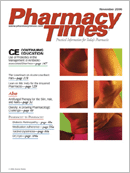Publication
Article
Pharmacy Times
A Pharmacist's Guide to OTC Therapy
Nearly everyone has sufferedfrom either a stuffy nose or apainful cold sore. Luckily, OTCtreatment options are available todecrease the bothersome symptomsof both conditions. Appropriate choiceand use of these products can help decreasethe discomfort of these naggingsituations.
Nasal Decongestants
Oral Decongestants
Oral decongestants work to relievenasal congestion by constricting theblood vessels of the nasal passages,resulting in a decreased swelling of thenasal passages and an increased size ofthe nasal cavity.1 Until recently, pseudoephedrinehad been the only option inoral decongestant therapy. Changes inlaw enforcement and retail policies, however,have restricted the sale of pseudoephedrinenationwide. These changesarose from the potential for pseudoephedrineto be illegally manufacturedinto methamphetamine. Effective September30, 2006, the FDA has restrictedthe sale of all pseudoephedrine to behindthe counter and requires patients to provideproper identification and a currentaddress prior to purchasing the product.2
Pseudoephedrine is available in a myriadof preparations, including regular-release(30-mg tablets, dosed as 2 tabletsevery 4 -6 hours) and sustained-releasetablets (120-mg tablets, dosed as 1 tabletevery 12 hours; and 240-mg tablets,dosed as 1 tablet every 24 hours). Themaximum daily dose of pseudoephedrineshould not exceed 240 mg.2
Although pseudoephedrine is stillavailable and offers tried-and-true efficacyas a nasal decongestant, people mayfind its limited availability inconvenient.Because it cannot be manufactured intomethamphetamine, many manufacturershave begun marketing phenylephrineas another option in oral nasal decongestanttherapy. Phenylephrine offers anequivalent product to people 12 yearsand older and is available over the counterwithout restrictions. The 10-mgphenylephrine tablets should be takenevery 4 hours as needed, with a maximumdaily dose of 60 mg.2
Topical Decongestants
Topical decongestants, available asdrops or sprays, offer quick and effectiverelief by acting directly on the tissue ofthe nasal passageways to decrease theswelling and congestion.1 Due to theirspeed and efficacy, topical decongestantsare often a popular choice for peoplewith nasal congestion (Table 13).
Appropriate use of topical decongestantsis extremely important. These productsshould never be used for more than72 consecutive hours. Topical decongestantshave been associated with a"rebound effect," which is described as aworsening of the congestion when thedecongestant wears off. As a result, theuser may increase the dose or frequencyof the product, only to have even worsecongestion when the increased dosewears off. The only way to break this cycleis to stop using the spray or drops altogether?even though it may take severaldays for the nasal passageways to returnto normal.4
Patient Education
Neither oral nor topical decongestantsshould be used in people with the followingdisease states: heart disease, hypertension,thyroid disease, diabetes, orenlarged prostate. Decongestants shouldnot be used during pregnancy or whilebreast-feeding unless under the advice ofa physician.4
People using a monoamine oxidaseinhibitor should not use nasal decongestants.1
Oral decongestants should not be usedfor longer than 7 days without consultinga physician. Sustained-release productsshould be swallowed whole. Side effectsof oral decongestants include an increasein blood pressure, nervousness, insomnia,palpitations, tremor, difficulty urinating,and decreased appetite.1
Cold Sore Products
Herpes simplex virus type 1 or 2 causesherpes labialis, commonly known as coldsores or fever blisters. They occur on thelips, nostrils, chin, or fingers and are oftenconfused with canker sores, which occurinside the mouth. Symptoms include prodromepain, which is an itching or tinglingpreceding the lesion by 1 to 2 days, as wellas fluid-filled blisters on a raised, red,painful skin area.The blisters form a yellowcrust that sloughs off to show pink skinthat heals without a scar in 7 to 14 days.5,6
Treatment Options
Although no medication can get rid ofthe viral infection completely, some treatmentscan shorten the duration of thesore and decrease pain. OTC topical anestheticsdo not affect the duration of thesore, but many people find them useful tominimize discomfort. Most nonprescriptionanesthetic products available containbenzocaine, camphor, phenol, alcohol, orany combination of those ingredients invarious topical vehicles, such as creams,gels, and lotions.7
The only nonprescription medicationavailable that actually has antiviral propertiesis docosanol 10% cream (Abreva).Docosanol may shorten healing timewhen used soon after the onset of symptoms.People using docosanol shouldwash their hands before and after applicationand gently and completely rub thecream in a thin layer 5 times a day until thesore is healed8 (Table 27).
In addition to topical anesthetics anddocosanol, OTC oral pain relievers may beuseful in reducing pain. Options includeaspirin, acetaminophen, or ibuprofen.Some people may find ice or warm applicationseffective at easing pain.6
Patient Education
Here are a few tips to avoid spreadingthe virus responsible for cold sores:
- Avoid touching the lesion. If contact ismade, be sure the hands are washedimmediately.
- Avoid sharing utensils, towels, andother items that come in contact withthe virus
- Avoid touching other parts of the body
- Avoid skin contact with others, as wellas kissing
- Avoid common cold sore triggers,such as too much sun exposure,stress, not getting enough sleep, andfever
- Do not squeeze or pick at the blister.Instead, care for the lesion by washingit gently with soap and water.
Self-treatment may not be appropriatefor everyone. People with an immunosuppressivedisorder, severe symptoms,frequent recurrence of cold sores,eye irritation, or a cold sore that lasts forover 1 or 2 weeks should see their physicianfor appropriate medical treatmentfor the cold sore.5
Dr. Holmberg is a pharmacist withPhoenix Children's Hospital, Phoenix,Ariz. Dr. Schott is a pharmacist withStop and Shop, Meriden, Conn.
For a list of references, send a stamped, self-addressedenvelope to: References Department,Attn. A. Rybovic, Pharmacy Times, AscendMedia Healthcare, 103 College Road East,Princeton, NJ 08540; or send an e-mailrequest to: [email protected].

Newsletter
Stay informed on drug updates, treatment guidelines, and pharmacy practice trends—subscribe to Pharmacy Times for weekly clinical insights.






